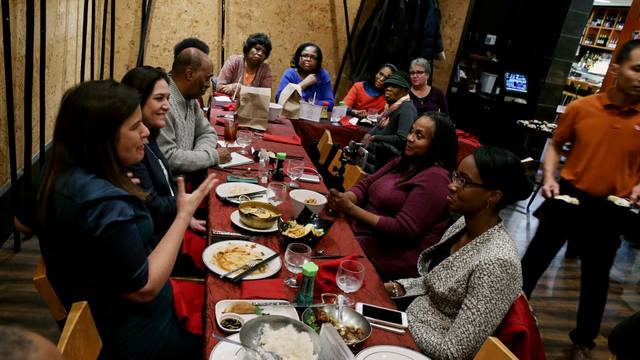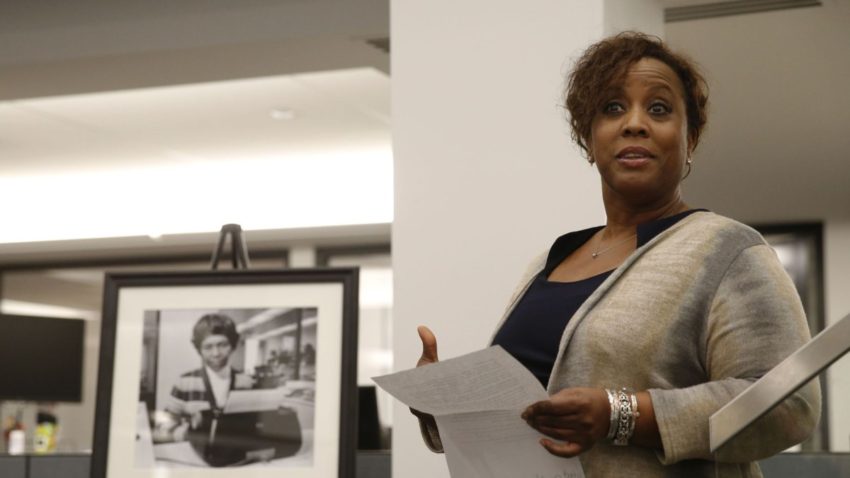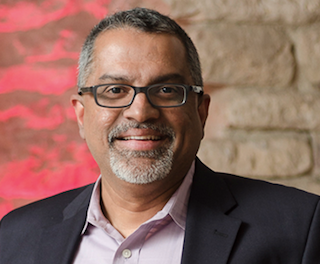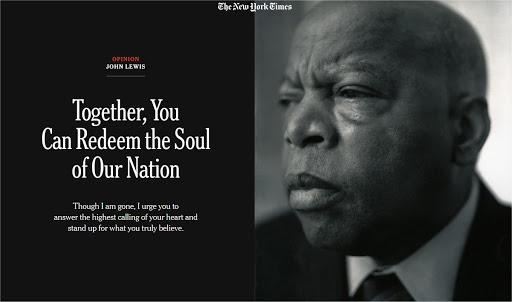Could Be That These New Titles Are Irrelevant
N.Y. Times, Xernona Clayton Shine on Lewis’ Day
Journal-isms Fund Drive Continues

Could Be That These New Titles Are Irrelevant
Krissah Thompson (pictured, below) was showered this week with congratulations, at least on social media, when The Washington Post named her its first-ever managing editor for diversity and inclusion. She became the first African American woman to become a managing editor.
 But not every message of congrats was unqualified. “I am proud of this sister and I know she will be a force,” tweeted Nikole Hannah-Jones of the New York Times Magazine and its 1619 Project, “but it’s also a bit of a gut punch that the first Black woman managing editor in the @washingtonpost 143-year history is managing editor of diversity and inclusion.”
But not every message of congrats was unqualified. “I am proud of this sister and I know she will be a force,” tweeted Nikole Hannah-Jones of the New York Times Magazine and its 1619 Project, “but it’s also a bit of a gut punch that the first Black woman managing editor in the @washingtonpost 143-year history is managing editor of diversity and inclusion.”
The recent spate of high-ranking “diversity and inclusion” appointments has struck some as ghettoizing what should be a priority for all staff. In addition, some see these jobs not having much teeth.
 “I haven’t really paid a whole lot of attention but at first blush it seems a throwback,” Gregory L. Moore (pictured), former editor of the Denver Post, messaged Journal-isms. “I do know this, if you don’t control resources or have the power to stop things from happening — you have little chance of success.”
“I haven’t really paid a whole lot of attention but at first blush it seems a throwback,” Gregory L. Moore (pictured), former editor of the Denver Post, messaged Journal-isms. “I do know this, if you don’t control resources or have the power to stop things from happening — you have little chance of success.”
 Hugo Balta (pictured), the president of the National Association of Hispanic Journalists who is news director of WTTW-TV, public television in Chicago, has held positions with “diversity” among his responsibilities at ESPN and ESPN Deportes.
Hugo Balta (pictured), the president of the National Association of Hispanic Journalists who is news director of WTTW-TV, public television in Chicago, has held positions with “diversity” among his responsibilities at ESPN and ESPN Deportes.
“It’s been my experience that those colorful titles are more often than not just a little paint and landscaping for curb appeal,” Balta messaged.
“It’s more important to learn what’s behind the facade — what authority, resources and influence the position actually has in order to effect positive change in the company.”
Bill Ross, executive director of the News Guild in Philadelphia, TNG-CWA Local 38010, messaged this about the Philadelphia Inquirer, where Michael Days is vice president for diversity and inclusion.
“With an organization that is so internally focused with the replacement of the Human Resources Department with People & Culture and with the creation of the VP of Diversity and Inclusion, it is baffling why there is so much internal unrest amongst all demographics within the newsroom. We believe the VP of Diversity and Inclusion is just a rebranding of the many roles and responsibilities Michael Days has fulfilled for many years. Without the authority to make decisions and drive change, it is a worthless title.” Days is a former editor of the Philadelphia Daily News.
Ross continued, “The Guild’s recent Gender/Diversity Pay Equity Analysis has shined a spotlight on where the real challenges are. The solutions are quite simple….commitment to better diverse recruitment, hiring and retention practices. Pay equity adjustments where warranted. And, the development of a newsroom management succession plan to create a more forward looking diverse newsroom management team.”
 Days (pictured) responded to Journal-isms, “Making real and lasting change at an organization goes beyond one person or one role. It takes commitment at every level. I am proud to be part of a leadership team that takes this work seriously, and I have always found my contributions to be real and valued.”
Days (pictured) responded to Journal-isms, “Making real and lasting change at an organization goes beyond one person or one role. It takes commitment at every level. I am proud to be part of a leadership team that takes this work seriously, and I have always found my contributions to be real and valued.”

For all the criticisms, there is no denying that “diversity and inclusion” positions are on the rise. A week before Thompson’s appointment, the Dallas Morning News promoted Leona Allen to deputy publisher “responsible for diversity and inclusion across the company.”
 Earlier this month, The Wall Street Journal promoted Brent Jones (pictured) to a new masthead position as editor of culture, training and outreach, in which he “will work closely with colleagues across Dow Jones and especially the People Team, which is driving efforts across the entire company on diversity, inclusion and Dow Jones culture.“
Earlier this month, The Wall Street Journal promoted Brent Jones (pictured) to a new masthead position as editor of culture, training and outreach, in which he “will work closely with colleagues across Dow Jones and especially the People Team, which is driving efforts across the entire company on diversity, inclusion and Dow Jones culture.“
This is not just a news media phenomenon.
“Diversity Officers have been on the ascent in the U.S. for some time, with the position experiencing a steady 17% annual increase in hiring since 2015, according to an analysis of LinkedIn data,” Caroline Fairchild wrote July 15 for LinkedIn News.
“But since the protests against systemic racism began, job listings for diversity and inclusion roles — including leadership positions such as Chief Diversity Officers, directors and managers — have skyrocketed. In the 45 days since the start of the protests [of the police killing of George Floyd], postings for such positions were up by nearly 100% compared to the 45 days prior to the wave of demonstrations. . . .”
In the Post’s announcement of Thompson’s appointment, Executive Editor Martin Baron said, “Krissah will be in charge of ensuring significant, consistent progress on diversity and inclusiveness in everything we do –- our coverage of race, ethnicity and identity as well as improved recruitment, retention and career advancement for journalists of color. She will have the strong backing of the newsroom’s senior leadership in that highest-priority effort. She will require the support of everyone.”
But Baron did not always favor such a position, Ben Smith reported in The New York Times June 28, updated June 30.
“The last time Mr. Baron faced sustained complaints from his black staff was in 2016, after [Managing Editor Kevin] Merida left,” Smith wrote. “Then, a group of black Posties sent Mr. Baron a memo making the case for a new deputy managing editor for diversity.” Referring to Tracy Grant, managing editor for staff development and standards, Smith continued, “Mr. Baron responded that The Post was relatively diverse compared with other newsrooms and that Grant had diversity issues in hand. ‘They represent the bulk of her work and the most rewarding aspects of her job,’ Mr. Baron wrote in the memo. ‘I can’t imagine taking them away from her.’
 “This time, as The Post rushed to quell the kind of staff uprising that broke out at The New York Times and The Los Angeles Times, that role suddenly held appeal to Mr. Baron. The Post announced on June 18 that it would hire for the role, and an internal email says the deadline for applying is July 3. Mr. Baron would vet applications himself, and he reached out to Shani O. Hilton (pictured), my former colleague [at BuzzFeed News] who is now a deputy managing editor at The Los Angeles Times overseeing its Washington bureau, its national coverage and its foreign desk, suggesting she apply. . . .
“This time, as The Post rushed to quell the kind of staff uprising that broke out at The New York Times and The Los Angeles Times, that role suddenly held appeal to Mr. Baron. The Post announced on June 18 that it would hire for the role, and an internal email says the deadline for applying is July 3. Mr. Baron would vet applications himself, and he reached out to Shani O. Hilton (pictured), my former colleague [at BuzzFeed News] who is now a deputy managing editor at The Los Angeles Times overseeing its Washington bureau, its national coverage and its foreign desk, suggesting she apply. . . .
“Ms. Hilton was not interested.
“ ‘I have seen over the years that diversity roles, particularly for black women, are the fastest way to be sidelined out of the most important conversations about coverage and hiring,’ she wrote back. ‘The moniker lets other managers think the work of improving representation and newsroom culture doesn’t fall on them.’ . . .”
Hilton told Journal-isms by telephone Thursday that she feels strongly about that. In fact, she said, she dissuaded Executive Editor Norman Pearlstine from creating a “diversity and inclusion” post and to name instead a senior editor for “talent and culture,” an appointment that will be forthcoming. That way, the diversity responsibility does not fall on one person, Hilton said.
Maribel Perez Wadsworth, publisher of USA Today, in December was also named president of news for the combined Gannett and GateHouse operations, now by far the nation’s largest newspaper company. She takes the position that titles are secondary to getting the job done; the issue is whether the companies “walk the talk.”
Gannett has long linked progress in diversity to supervisors’ evaluations and overall compensation, a concept known as pay at risk, and Wadsworth, who approves every senior-level news appointment, said that of 11 senior hires made since January, only two have been white males.
She also added “inclusion” to the title of the standards and ethics editor, currently Michael McCarter, because “it sends an important signal.” Being aware of structural racism is the job of every reporter, she said. She added that she will soon be announcing structural changes at the local newspapers that reflect that.
Asked about structural racism in the news business, Wadsworth said employees undergo training in unconscious bias.
Though the L.A. Times and Gannett eschew separate “diversity and inclusion” jobs, many see them as progress.
 Alice Bonner (pictured), a Ph.D. who has worked for both the Post and Gannett and has held positions involving diversity, messaged, “At the Washington Post in the early 1980s, I was allowed to informally advise careers, conduct performance evaluations, support applications for growth opportunities, recommend promotions and even attend recruiting events — all needed and on my own initiative though they were actions beyond my [assistant city] editor duties.
Alice Bonner (pictured), a Ph.D. who has worked for both the Post and Gannett and has held positions involving diversity, messaged, “At the Washington Post in the early 1980s, I was allowed to informally advise careers, conduct performance evaluations, support applications for growth opportunities, recommend promotions and even attend recruiting events — all needed and on my own initiative though they were actions beyond my [assistant city] editor duties.
“But when I proposed creation of a formal newsroom position, I was told bluntly (and illegally) that the paper was ‘not ready for a black woman in such a position.’ “
However, Bonner also says, “History documents that these jobs would be unnecessary if the news industries were genuinely determined and interested in making their products and personnel truly representative of American diversity. Also, it is telling that the appointees tend to be minority-group professionals, which automatically signals that these are set-aside positions with optional missions, offering shiny new opportunities for individuals in lieu of across-the-board change and real commitment to equality of coverage and staffing.”
 Raju Narisetti (pictured), who has held a variety of news executive positions, including at the Post, offered his version of the Ronald Reagan mantra, “trust but verify.”
Raju Narisetti (pictured), who has held a variety of news executive positions, including at the Post, offered his version of the Ronald Reagan mantra, “trust but verify.”
“When a smart person is chosen for a new role that is in the leadership ranks of an organization, we have to start with the assumption that there is both intent and desire to back up that decision, and there is little reason to assume the worst, especially at The Washington Post where I know many of the current leaders,” Narisetti said by email.
“My larger point is that the absence of such a specific role (or just the presence) doesn’t mean real change will happen and be sustained. We have to trust the intent but verify the outcomes, which is why I like to start with data and establishing baselines. And, hopefully, those who pay attention on the outside, including you, as you have done for years, will revisit 6-12-18 months in, and ask for receipts — for measurable change and progress.”
Narisetti added, “The New York Times has embraced a public accounting of its diversity ranks and hiring through its annual diversity and inclusion report, something we did back when I was CEO of Gizmodo Media Group, as did BuzzFeed, and as does Marshall Project to name some digital newsrooms that first took the initiative, when mainstream traditional media was refusing to participate in ASNE [American Society of News Editors] surveys and provide any data that would allow us to measure progress or lack thereof.”
After Narisetti’s message, The Washington Post Thursday released the demographic breakdown of its own workforce.

Bonner suggests those named to these new positions check in with each other
“Above all, today’s appointees to ‘diversity’ positions in news organizations will need each other,” she messaged. “I’d urge those newly named to such jobs to quickly organize and set up structures for mutual support and collective strength. If they develop a set of fundamental practices and principles broad enough to support the range of different organizations they should seek their bosses’ endorsement.
“Then they will not have to re-invent the wheel, as has been done for decades now. Such action also will provide job security as each officer will inevitably have to work around the kind of adversity and resistance that made the jobs necessary in the first place.
“Vestiges of bias will make this work more difficult if the appointees yield their own ideas of what their mission should be to upper management. Such an organization should embrace the slogan, ‘I am not your window-dressing. ‘ “
- Washington Post: Five questions with Krissah Thompson

N.Y. Times, Xernona Clayton Shine on Lewis’ Day
The New York Times scored a journalistic coup by publishing Rep. John Lewis‘ final op-ed, and Xernona Clayton, a member of the National Association of Black Journalists Hall of Fame, stole the show at the Thursday service by recounting how she introduced Lewis to his late wife, Lillian.
“The brief essay that Representative John Lewis sent me two days before his death — to be published today, on the occasion of his funeral — expresses the hope for national healing and reconciliation that guided his life’s work,” Kathleen Kingsbury, acting Times editorial page editor, wrote Thursday.
Lewis was a member of Congress for 33 years before his death from pancreatic cancer on July 17.
Kingsbury also wrote of Lewis, who was 80, “His final words ask us to cast our eyes forward. ‘Democracy is not a state. It is an act, and each generation must do its part to help build what we called the Beloved Community, a nation and world society at peace with itself,’ he wrote in today’s Op-Ed. I’d also recommend listening to it being read aloud in the powerful audio version,” delivered by Prentice Onayemi.
On MSNBC, historian Jon Meacham called Clayton’s appearance the show-stealer of the services at Atlanta’s Ebenezer Baptist Church — at least in entertainment value — despite the presence of three U.S. presidents and other luminaries.
Unlike them, Clayton might not be well-known to the general public. But she is an Atlanta icon and was inducted into the NABJ Hall of Fame in 2007.
She turns 90 on Aug. 30 and like Lewis, was a member of Martin Luther King Jr.‘s inner circle.
Clayton “left the audience chuckling after telling how she finagled to set up Lewis with his late wife Lillian Miles, and how long it took the relationship to get off the ground because the shy and reserved ‘John was too slow,’ ” Ernie Suggs, Tia Mitchell and Maya T. Prabhu wrote for the Atlanta Journal-Constitution. She also tells the story in the recently released documentary about Lewis, “Good Trouble.”

Clayton is also the founder, president and CEO of the Trumpet Awards Foundation, Inc., and creator and executive producer of the foundation’s Trumpet Awards, “a prestigious event highlighting African American accomplishments and contributions,” according to her bio.
The bio continues, “Ms. Clayton began her television career in 1967 and became the south’s first Black person to have her own television show. The Xernona Clayton show was a regular feature on WAGA-TV, CBS affiliate in Atlanta.
“Xernona Clayton was employed at Turner Broadcasting for nearly 30 years where she served as a corporate executive. In 1988, Xernona Clayton was appointed Corporate Vice President for Urban Affairs with Turner Broadcasting System, Inc. In this capacity, she directed internal and external projects for the Corporation, and served as liaison between Turner Broadcasting (TBS SuperStation, CNN, Headline News, TNT, Atlanta Braves and Atlanta Hawks) and civic groups in Atlanta and across the country. As a corporate executive, Ms. Clayton was one of the highest-ranking female employees in Turner Broadcasting System.
“Xernona moved to Atlanta in 1965 where she accepted a position with the Southern Christian Leadership Conference and worked closely with the late Dr. Martin Luther King, Jr. Ms. Clayton also traveled extensively with Mrs. Coretta Scott King on her nationwide concert tours. . . .”
A scholarship fund from the Atlanta Association of Black Journalists bears Clayton’s name, and in 2012, the city dedicated a street and park plaza in her name at Peachtree and Baker streets downtown.
She became the second woman to be so honored in the city.
“Gone With the Wind” author Margaret Mitchell is the other.
- Jon Allsop, Columbia Journalism Review: The media’s vital role in safeguarding elections (June 12)
- Joyce Ferriabough Bolling, Boston Herald: Renaming Pettus Bridge not good enough for John Lewis
- Lonnie G. Bunch III, Politico Magazine: What John Lewis Taught Me
- Mary C. Curtis, Roll Call: Trump in trouble revisits his tried-and-true — protecting your neighborhood from ‘them’
- Jim Galloway, Atlanta Journal-Constitution: John Lewis set the theme for his own funeral. Donald Trump showed why it was necessary
- Maureen Groppe and Nicholas Wu, USA Today: In John Lewis’ footsteps: Four House candidates from a new generation to watch
- Jack Holmes, Esquire: In His Eulogy for John Lewis, Barack Obama Just Changed the Landscape of a Joe Biden Presidency
- Earl Ofari Hutchinson, Hutchinson Report: Trump’s Naked Race Card Play Might Even Make Wallace Blush
- Maya King, Politico: From Bloody Sunday to Black Lives Matter, the role of the Black church is shifting
- Harry Kretchmer, World Economic Forum: After John Lewis: 21 civil rights leaders who are shaping America (includes Jose Antonio Vargas, Van Jones)
- NBC News: Obama eulogizes John Lewis at Ebenezer Baptist Church in Atlanta (video)
- Caitlin O’Kane, CBS News: John Lewis and wife Lillian’s love story was shared during his funeral by the friend who set them up (video)
Journal-isms Fund Drive Continues

“As a veteran reporter, I turn to Richard Prince’s Journal-isms all the time for the latest information on people of color in our business. There is no spin, no slant, just the facts to keep us informed. I also appreciate that he holds journalists and media companies accountable . . . . Keep up the good work. #NoSpinAllowed” (Courtesy Rebecca Aguilar)
— Rebecca Aguilar, freelance reporter; diversity committee chair, Society of Professional Journalists; former vice president, National Association of Hispanic Journalists. Support Journal-isms here or here
Support Journal-ismsFacebook users: “Like” “Richard Prince’s Journal-isms” on Facebook.
Follow Richard Prince on Twitter @princeeditor
Richard Prince’s Journal-isms originates from Washington. It began in print before most of us knew what the internet was, and it would like to be referred to as a “column.” Any views expressed in the column are those of the person or organization quoted and not those of any other entity. Send tips, comments and concerns to Richard Prince at journal-isms-owner@yahoogroups.com
View previous columns (after Feb. 13, 2016).
- Diversity’s Greatest Hits, 2018 (Jan. 4, 2019)
- Book Notes: Is Taking a Knee Really All That? (Dec. 20, 2018)
- Book Notes: Challenging ’45’ and Proudly Telling the Story (Dec. 18, 2018)
- Book Notes: Get Down With the Legends! (Dec. 11, 2018)
- Journalist Richard Prince w/Joe Madison (Sirius XM, April 18, 2018) (podcast)
- Richard Prince (journalist) (Wikipedia entry)
- February 2018 Podcast: Richard “Dick” Prince on the need for newsroom diversity (Gabriel Greschler, Student Press Law Center, Feb. 26, 2018)
- Diversity’s Greatest Hits, 2017 — Where Will They Take Us in the Year Ahead?
- Book Notes: Best Sellers, Uncovered Treasures, Overlooked History (Dec. 19, 2017)
- An advocate for diversity in the media is still pressing for representation, (Courtland Milloy, Washington Post, Nov. 28, 2017)
- Morgan Global Journalism Review: Journal-isms Journeys On (Aug. 31, 2017)
- Diversity’s Greatest Hits, 2016
- Book Notes: 16 Writers Dish About ‘Chelle,’ the First Lady
- Book Notes: From Coretta to Barack, and in Search of the Godfather
- Journal-isms’ Richard Prince Wants Your Ideas (FishbowlDC, Feb. 26, 2016)
- “JOURNAL-ISMS” IS LATEST TO BEAR BRUNT OF INDUSTRY’S ECONOMIC WOES (Feb. 19, 2016)
- Richard Prince with Charlayne Hunter-Gault,“PBS NewsHour,” “What stagnant diversity means for America’s newsrooms” (Dec. 15, 2015)
- Book Notes: Journalists Follow Their Passions
- Book Notes: Journalists Who Rocked Their World
- Book Notes: Hands Up! Read This!
- Book Notes: New Cosby Bio Looks Like a Best-Seller
- Journo-diversity advocate turns attention to Ezra Klein project (Erik Wemple, Washington Post, March 5, 2014)
- Correction: This column originally said Krissah Thompson would be the first African American woman on the Washington Post masthead. The Post actually said she would be the first to become a managing editor.

